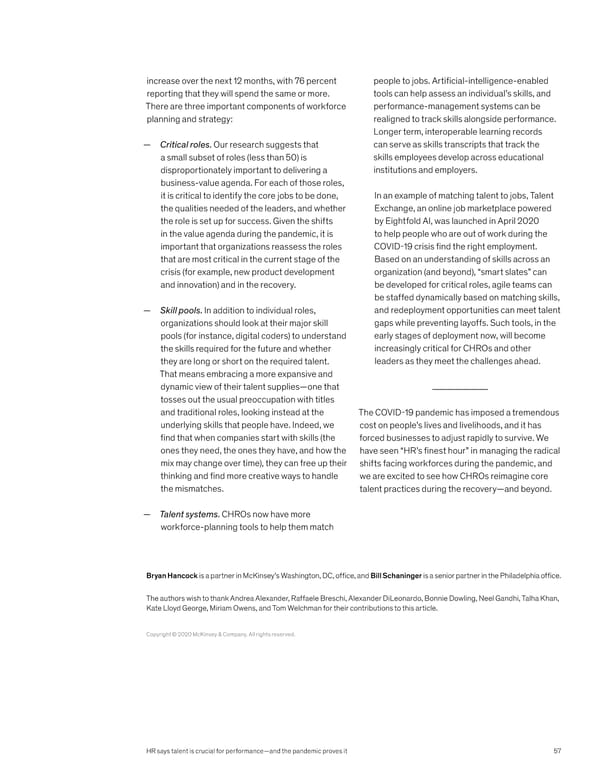increase over the next 12 months, with 76 percent people to jobs. Artificial-intelligence-enabled reporting that they will spend the same or more. tools can help assess an individual’s skills, and There are three important components of workforce performance-management systems can be planning and strategy: realigned to track skills alongside performance. Longer term, interoperable learning records — Critical roles. Our research suggests that can serve as skills transcripts that track the a small subset of roles (less than 50) is skills employees develop across educational disproportionately important to delivering a institutions and employers. business-value agenda. For each of those roles, it is critical to identify the core jobs to be done, In an example of matching talent to jobs, Talent the qualities needed of the leaders, and whether Exchange, an online job marketplace powered the role is set up for success. Given the shifts by Eightfold AI, was launched in April 2020 in the value agenda during the pandemic, it is to help people who are out of work during the important that organizations reassess the roles COVID-19 crisis find the right employment. that are most critical in the current stage of the Based on an understanding of skills across an crisis (for example, new product development organization (and beyond), “smart slates” can and innovation) and in the recovery. be developed for critical roles, agile teams can be staffed dynamically based on matching skills, — Skill pools. In addition to individual roles, and redeployment opportunities can meet talent organizations should look at their major skill gaps while preventing layoffs. Such tools, in the pools (for instance, digital coders) to understand early stages of deployment now, will become the skills required for the future and whether increasingly critical for CHROs and other they are long or short on the required talent. leaders as they meet the challenges ahead. That means embracing a more expansive and dynamic view of their talent supplies—one that tosses out the usual preoccupation with titles and traditional roles, looking instead at the The COVID-19 pandemic has imposed a tremendous underlying skills that people have. Indeed, we cost on people’s lives and livelihoods, and it has find that when companies start with skills (the forced businesses to adjust rapidly to survive. We ones they need, the ones they have, and how the have seen “HR’s finest hour” in managing the radical mix may change over time), they can free up their shifts facing workforces during the pandemic, and thinking and find more creative ways to handle we are excited to see how CHROs reimagine core the mismatches. talent practices during the recovery—and beyond. — Talent systems. CHROs now have more workforce-planning tools to help them match Bryan Hancock is a partner in McKinsey’s Washington, DC, office, and Bill Schaninger is a senior partner in the Philadelphia office. The authors wish to thank Andrea Alexander, Raffaele Breschi, Alexander DiLeonardo, Bonnie Dowling, Neel Gandhi, Talha Khan, Kate Lloyd George, Miriam Owens, and Tom Welchman for their contributions to this article. Copyright © 2020 McKinsey & Company. All rights reserved. HR says talent is crucial for performance—and the pandemic proves it 57
 What Now? Page 58 Page 60
What Now? Page 58 Page 60